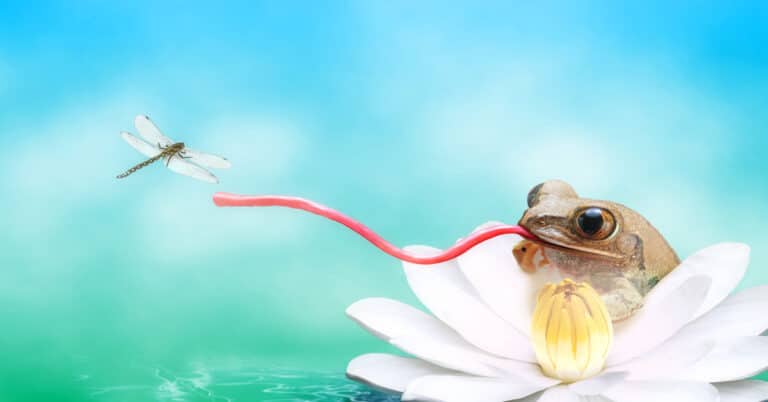Green Tree Frogs

The green tree frog is a slender and nocturnal frog that lives in trees and bushes and lays eggs in ponds. Usually, they come in different sizes and abilities, depending on their geographical location. Tree frogs have a diverse family that includes over 800 species of frogs.
Unlike what the name suggests, not every tree frog lives on trees, but the thing that unites them under the same category is their feet. The last bone inside their toes is shaped like a claw. Moreover, their feet also contain toe pads, which can help them climb.
There is a diverse range of the size of these green tree frogs. The species also includes frogs as small as 2.5 centimeters, relying on leaves and branches to hold their weight. Meanwhile, the largest tree frog may reach up to 12 centimeters.

Range of Green Tree Frogs
The green tree frogs are spread throughout the world, but they are densely populated in the world’s Western hemisphere. They are found on every continent except Antarctica. Over 600 green tree frogs species exist in South and Central America. Mostly, the area they live in is moist ground, usually around lakes and ponds.
They are often prey for carnivore animals, including fishes, birds, mammals, and reptiles. Green tree frogs depend on camouflage to defend themselves from predators, and since they are green in color, the bushes and trees help them.
Life Cycle of Green Tree Frogs
All male green tree frogs use the help of sound to attract female suitors. Female frogs often wait for these calls from their specie. They will produce the most commonly known sound, “ribbetting,” which everyone associates with nearly every frog species.
Some of the frig species hatch as miniature adults, but commonly, their journey starts from being a tadpole. The lifespan similarly varies among different species. One of the longest living species of a green tree frog is the Australian tree frog, which can live for 15 years. On the other hand, some species live just under two years. On average, the typical life of a green tree frog is between 5-and 9 years.
Behavior
Overall, green tree frogs are shy and stay awake all night to hunt insects. Therefore, they are very likely to appear at night near the porch lights where bugs gather. However, they don’t venture outside their habitat since they heavily rely on moist areas and water.
Appearance

Some green frog species can change their color, just like chameleons, to hide from predators. Their ability may depend on their environment and other factors such as the overall temperature, lighting, and other surrounding conditions.
Diet
Green tree frogs usually feed on flies, mosquitoes, crickets, locusts, and other smaller insects, just like other species of frogs. These frogs only possess teeth on their upper jaw, which helps them keep their prey intact and don’t let it escape. Their tongues, on the other hand, are very long and may reach up to 1/3rd of the size of their bodies. These frogs can use their tongues to catch prey. Normally, they stick out their tongue to attract prey. Once the prey lands on their tongue, they instantly retract it.
Predators and Threats
Since these frogs don’t have a compact defense mechanism, they are easy prey for many carnivores. Among many other animals, such as snakes and birds, cats and dogs often prey on them. In the wild, their average age is only 5-9 years, and however, when they become pets, the same frog can live up to 15 years.
Moreover, when they are in the water, they face a constant threat from predatory fishes that would latch onto them. Especially as tadpoles, they are at a higher risk since water insects can also prey on them.
Apart from the predator threats, they also face habitat destruction problems resulting from drainage and industrialization. Their populations have declined sharply, especially due to these developments. Amphibian species remain under the threat of forest clearing and industrialization. The rise in pollution may have proved to be a catalyst for the dwindling population of this frog species.
Interesting Facts about Green Tree Frogs
There are numerous green tree frog facts and things you should know about. Below we will take a look at some interesting facts about green frogs:
They Honk 75 Times per Minute
Green frogs are also known as “bell frogs,” You may know why that’s the case. Their mating call is a “Honk” that they repeat up to 75 times per minute! Female frogs can hear that they are within 250 meters.
Free Pest Control
Green frogs often eat insects that are dangerous to humans. They significantly reduce the malaria-causing mosquitoes, but they also take on other nuance insects.
Not All Green Frogs are Green
There are skin variations in terms of colors for green tree frogs. While the majority of them are still green, some species are not. For instance, you can find lime colors, frogs and olive, and brown in Southern America.
Many People Keep Them as Pets
Since these frogs are small and vibrant, many people adore them as pets. However, they need to be careful since these frogs can cause significant problems such as fungi and other diseases. Therefore, it is better to know the origins first and adopt them as pets. It is hard to take care of green tree frogs that are wild.
Final Thoughts
Green tree frogs are much more common than we think. Their sounds are popular in Hollywood movies, along with the chirp of crickets. Often, they go unnoticed and overlooked even when they are on our porch, singing under the lights.













Having discovered a fondness for insects while pursuing her degree in Biology, Randi Jones was quite bugged to know that people usually dismissed these little creatures as “creepy-crawlies”.







